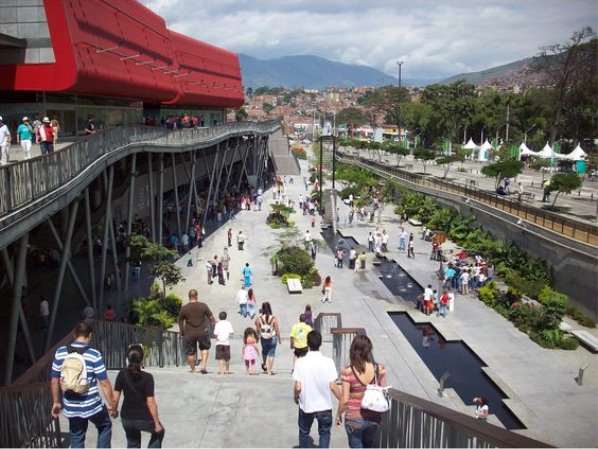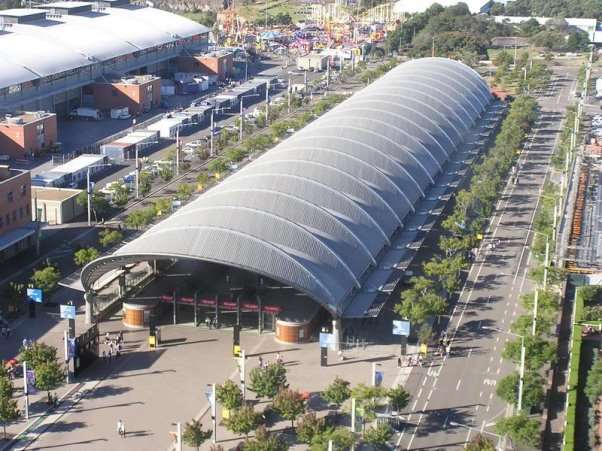Architecture as a Strategy for Crime Control
| ✅ Paper Type: Free Essay | ✅ Subject: Architecture |
| ✅ Wordcount: 2141 words | ✅ Published: 30th Apr 2018 |
Urban Densification: Is it really the solution for sustainable cities?
Architecture: The Tool for Crime Control

Figure 1.” The design of buildings and the arrangement of streets, public spaces and green areas might reduce crime rates” – The Parque Explora, Medellin, Colombia (American Society of Landscape Architects 2014).
The worldwide concern about population growth and rapid urbanisation in many cities around the world has brought with it many social problems affecting sustainability and quality of life. Among the most serious social problems are crime and segregation. There is no doubt that crime and segregation are influenced by a multiplicity of factors such as economic, social, and governmental as well as physical elements (Marzbali et al. 2011). This disorderly expansion and informal settlements are generating “empty” spaces in the cities, creating a rupture in the urban fabric. Physical elements such as Rivers, railways, freeways even buildings are contributing to this rupture creating “Social-Urban Barriers” in cities.
Get Help With Your Essay
If you need assistance with writing your essay, our professional essay writing service is here to help!
Find out more about our Essay Writing Service
Katyal (2002) states that Governments need to pay special attention to the built environment towards the reduction of crime and social segregation. The design of buildings and the arrangement of streets, public spaces and green areas can affect the opportunity of crime (Soomeren 2008). The prevention of crime through environmental design or through urban planning and architectural design accompanied by community’s participation has proven to be a useful, effective, and feasible strategy to prevent crime and the sense of insecurity in cities (Marzbali et al. 2011). Countries throughout the world, such as Basil, Colombia, Australia, Japan, and Great Britain have used architectural design techniques to prevent crime. For example, the 2000 Sydney Olympics games, cleverly employed architecture to reduce crime by linking the new facilities with the existing neighbourhood (footpaths and streets), increasing street lighting in footpaths, modifying landscapes and creating visibility around stadiums (Katyal 2002). Therefore, this helped to increase profits, reduce incidents, and improvement on accessibility and enjoyment of the events.

Figure 2. Sydney Olympic Park Railway Station – Architects cleverly modified landscapes and created visibility around facilities (Skyscraperscity.com 2006).
A large number of experiments have shown that the number of certain types of crime can be reduced by modifying the opportunity to commit a crime in the built environment without having to move the place where the crime takes place (Marzbali et al. 2011). One of the most well-known and used methodologies for crime prevention around the world is the Crime Prevention Through Environmental Design (CPTED). The CPTED approach starts from the premise that, in certain spaces, crimes are the result of the opportunities offered by the same physical environment (The State of Queensland 2007). This provides the basis for proposing that in order to reduce the likelihood of crimes, it is necessary to alter the physical environment. The strategies employed in this approach are (1) passive or natural surveillance; (2) natural access control; (3) territorial reinforcement and (4) maintenance (Katyal 2002). In addition, Katyal (2002) explains that the design should create opportunities for natural surveillance by residents, neighbours and visitors and instil a sense of territoriality so that residents to develop proprietary attitudes and outsiders feel deterred from entering a private space. So, the goal is to build communities and avoid social segregation.
A good example of the prevention of crime through environmental design or through urban planning and architecture has been taken place in Medellín, Colombia, the former “The world’s most violent city”, which, by providing quality public transport to marginalized areas (Metrocable), improvement of public space, creation of library parks (active all day), accompanied by other policies to promote vitality in the community (such as the creation of businesses), gave rise to the recovery of a marginal neighbourhood and the reduction of crime (Medina 2014).

Figure 3. ” As part of an extensive urban integration project in a huge informal settlement in Medellín, Colombia, the recently-constructed system of escalators with public squares and balconies addresses serious problems regarding connectivity, security and coexist” (Jordana 2013).
Undoubtedly interventions of the built environment allow preventing crime by fostering life on the streets and building communities, as well as improving social sustainability in cities. Architects, Urban Planners and others design professionals should take into consideration the surrounding environment in order to reduce crime rates. This intervention also requires among others, a properly functioning police force and criminal justice systems along with a model of economic development that creates viable opportunities to escape poverty and reduce social inequality.
References
Jordana, Sebastian. 2013. “Awards Competition Boosts Momentum of Sustainable Construction.” http://www.archdaily.com/436890/awards-competition-boosts-momentum-of-sustainable-construction, accessed 27-03-2017.
Katyal, Neal Kumar 2002. “Architecture as Crime Control.” The Yale Law Journal 111 (1039):1039-1139.
Marzbali, Massoomeh Hedayati, Aldrin Abdullah, Nordin Abd Razak, and Mohammad Javad Maghsoodi Tilaki. 2011. “A Review of the Effectiveness of Crime Prevention by Design Approaches towards Sustainable Development.” Journal of Sustainable Development 4 (1). doi: http://dx.doi.org/10.5539/jsd.v4n1p160
Medina, Salvador. 2014. “La ciudad como estrategia preventiva contra el crimen [The city as a preventive strategy against crime.].” http://labrujula.nexos.com.mx/?p=115, accessed 23-03-2017.
Skyscraperscity.com. 2006. “Sydney Olimpic Park.” http://www.skyscrapercity.com/showthread.php?t=460665, accessed 27-03-2017.
Soomeren, Paul Van. 2008. “Prevención de la delincuencia mediante el diseño ambiental y mediante el espacio urbano y arquitectónico [Prevention of crime through environmental design and urban and architectural space].” Fundación Democracia y Gobierno Local y Diputació de Barcelona:273-306.
The State of Queensland. 2007. “Crime Prevention through Environmental Design.” Guidelines for Queensland 1.
Jordana, Sebastian. 2013. “Awards Competition Boosts Momentum of Sustainable Construction.” http://www.archdaily.com/436890/awards-competition-boosts-momentum-of-sustainable-construction, accessed 27-03-2017.
Katyal, Neal Kumar 2002. “Architecture as Crime Control.” The Yale Law Journal 111 (1039):1039-1139.
Marzbali, Massoomeh Hedayati, Aldrin Abdullah, Nordin Abd Razak, and Mohammad Javad Maghsoodi Tilaki. 2011. “A Review of the Effectiveness of Crime Prevention by Design Approaches towards Sustainable Development.” Journal of Sustainable Development 4 (1). doi: http://dx.doi.org/10.5539/jsd.v4n1p160
Medina, Salvador. 2014. “La ciudad como estrategia preventiva contra el crimen [The city as a preventive strategy against crime.].” http://labrujula.nexos.com.mx/?p=115, accessed 23-03-2017.
Soomeren, Paul Van. 2008. “Prevención de la delincuencia mediante el diseño ambiental y mediante el espacio urbano y arquitectónico [Prevention of crime through environmental design and urban and architectural space].” Fundación Democracia y Gobierno Local y Diputació de Barcelona:273-306.
The State of Queensland. 2007. “Crime Prevention through Environmental Design.” Guidelines for Queensland 1.
American Society of Landscape Architects. 2014. “Medellin’s Social Innovation.” https://dirt.asla.org/2014/04/10/medellins-amazing-transformation/, accessed 27-03-2017.
Jordana, Sebastian. 2013. “Awards Competition Boosts Momentum of Sustainable Construction.” http://www.archdaily.com/436890/awards-competition-boosts-momentum-of-sustainable-construction, accessed 27-03-2017.
Katyal, Neal Kumar 2002. “Architecture as Crime Control.” The Yale Law Journal 111 (1039):1039-1139.
Marzbali, Massoomeh Hedayati, Aldrin Abdullah, Nordin Abd Razak, and Mohammad Javad Maghsoodi Tilaki. 2011. “A Review of the Effectiveness of Crime Prevention by Design Approaches towards Sustainable Development.” Journal of Sustainable Development 4 (1). doi: http://dx.doi.org/10.5539/jsd.v4n1p160
Medina, Salvador. 2014. “La ciudad como estrategia preventiva contra el crimen [The city as a preventive strategy against crime.].” http://labrujula.nexos.com.mx/?p=115, accessed 23-03-2017.
Soomeren, Paul Van. 2008. “Prevención de la delincuencia mediante el diseño ambiental y mediante el espacio urbano y arquitectónico [Prevention of crime through environmental design and urban and architectural space].” Fundación Democracia y Gobierno Local y Diputació de Barcelona:273-306.
The State of Queensland. 2007. “Crime Prevention through Environmental Design.” Guidelines for Queensland 1.
Katyal, Neal Kumar 2002. “Architecture as Crime Control.” The Yale Law Journal 111 (1039):1039-1139.
Marzbali, Massoomeh Hedayati, Aldrin Abdullah, Nordin Abd Razak, and Mohammad Javad Maghsoodi Tilaki. 2011. “A Review of the Effectiveness of Crime Prevention by Design Approaches towards Sustainable Development.” Journal of Sustainable Development 4 (1). doi: http://dx.doi.org/10.5539/jsd.v4n1p160
Medina, Salvador. 2014. “La ciudad como estrategia preventiva contra el crimen [The city as a preventive strategy against crime.].” http://labrujula.nexos.com.mx/?p=115, accessed 23-03-2017.
Netherlands Architecture Institute. 2013. “Parque Explora.” http://en.nai.nl/platform/innovation_agenda/item/_pid/kolom2-1/_rp_kolom2-1_elementId/1_1042577, accessed 27-03-2017.
Soomeren, Paul Van. 2008. “Prevención de la delincuencia mediante el diseño ambiental y mediante el espacio urbano y arquitectónico [Prevention of crime through environmental design and urban and architectural space].” Fundación Democracia y Gobierno Local y Diputació de Barcelona:273-306.
The State of Queensland. 2007. “Crime Prevention through Environmental Design.” Guidelines for Queensland 1.
Katyal, Neal Kumar 2002. “Architecture as Crime Control.” The Yale Law Journal 111 (1039):1039-1139.
Marzbali, Massoomeh Hedayati, Aldrin Abdullah, Nordin Abd Razak, and Mohammad Javad Maghsoodi Tilaki. 2011. “A Review of the Effectiveness of Crime Prevention by Design Approaches towards Sustainable Development.” Journal of Sustainable Development 4 (1). doi: http://dx.doi.org/10.5539/jsd.v4n1p160
Medina, Salvador. 2014. “La ciudad como estrategia preventiva contra el crimen [The city as a preventive strategy against crime.].” http://labrujula.nexos.com.mx/?p=115, accessed 23-03-2017.
Soomeren, Paul Van. 2008. “Prevención de la delincuencia mediante el diseño ambiental y mediante el espacio urbano y arquitectónico [Prevention of crime through environmental design and urban and architectural space].” Fundación Democracia y Gobierno Local y Diputació de Barcelona:273-306.
The State of Queensland. 2007. “Crime Prevention through Environmental Design.” Guidelines for Queensland 1.
Cite This Work
To export a reference to this article please select a referencing stye below:
Related Services
View allDMCA / Removal Request
If you are the original writer of this essay and no longer wish to have your work published on UKEssays.com then please click the following link to email our support team::
Request essay removal


